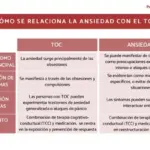Anxiety is one of the main reasons why people request psychological help Whether in the form of phobias, generalized anxiety, obsessions, panic attacks, anxiety derived from stress, etc.
In my office in Las Palmas de Gran Canaria I see people with anxiety disorders every day. It is a great effort that I make with my patients to prevent anxiety from continuing to control their lives. And the effort is rewarded, since a very high percentage of them manages to achieve the well-being they so desperately needed. What can be done in therapy in these cases? Let’s see it.
What is the usual treatment for anxiety?
Pathological anxiety has two main symptoms that are the focus of treatment. One of them is worries or anxious thoughts. The other is the overactivation (nervousness, tension, tachycardia, etc.) that accompanies the cognitive component.
Traditional cognitive-behavioral therapy focuses its treatment on these two components as follows:
For physiological overactivation
Relaxation techniques are used , such as controlled breathing or progressive muscle relaxation. Exposure exercises are also carried out, when possible, to situations that cause anxiety.
By approaching anxiety-producing stimuli, habituation to them occurs, reducing the feeling of nervousness.
Concerns
As for concerns, verbal cognitive restructuring and behavioral experiments have demonstrated great effectiveness.
With the help of restructuring, concerns begin to be recognized and identified. On the other hand, there is debate about the intolerance of uncertainty and the need to face the feeling of not being able to control certain aspects of life. The usefulness of concerns is also reevaluated and the beliefs that support them are worked on.
Finally, behavioral experiments are created to expose the person to the results of the predictions of their concerns. Thanks to these experiments patients’ beliefs are disconfirmed which usually predict much worse results than what happens in the end.
The usefulness of Mindfulness
Cognitive-behavioral therapy for anxiety, in each of its manifestations, has scientifically proven its effectiveness in a multitude of studies. So… Why include Mindfulness in treatment?
The difficulty of controlling thoughts
It is well known that trying to control or change thoughts is an arduous task. Sometimes we can’t remember something we want and other times, anxious thoughts come to our mind without control. In fact, the more we try to remember, the more we become blocked. AND The more we try to forget, the more present our thoughts are
It is estimated that we have about 4,000 thoughts during our waking state, which last only a few seconds, and rarely have to do with the task we are performing. They are automatic thoughts of all kinds, some neutral, others pleasant, many of them absurd and others unpleasant.
People with anxiety problems They tend to get hooked on unpleasant thoughts and recreate them over and over again along with an unpleasant mood.
An alternative solution
Many of the automatic thoughts that cause us distress, as well as some of the beliefs that govern our lives, can be reevaluated and restructured. These changes that occur thanks to The rationalization of certain thoughts and mental schemes results in an improvement in the quality of life and the well-being of people.
But there are times when thoughts or beliefs cannot be changed, or doing so could lead to greater discomfort than the current one. It is then where I have found the extraordinary usefulness of third generation therapies.
Acceptance and Commitment Therapy (ACT)
ACT belongs to the latest generation of cognitive-behavioral therapies, and emphasizes the need to release control of internal events and accept experiences as they come One of the most serious problems we suffer is due to the so-called “experiential avoidance.” We strive to avoid feeling or thinking unpleasant things and we try to control them as we do with external events.
If we want to stop watching Tele5, we just have to change the channel. If we want to stop thinking that our son will have an accident when he goes out partying in the car, and not feel distressed about it, that is more complicated.
The result of avoiding at all costs these emotions, thoughts and physical sensations that we find unpleasant, is to stop living to dedicate ourselves body and soul to fighting against our “problem”. The effort in Acceptance and Commitment Therapy is put into recovering or find a life with meaning, based on the values of each person
To manage intrusive thoughts, ACT has developed a technique called cognitive defusion One of the goals of this technique is to show that thoughts are just that, thoughts or memories, and that they should not be confused with their referents (real events that cause fear or anxiety).
Cognitive defusion is achieved when the patient reaches a more objective and distance yourself from your own thoughts thus decreasing credibility and attachment to them, with a consequent improvement in mood.
What does Mindfulness provide?
Surely we all already have a formed idea of what Mindfulness is. Its rise in recent years has caused it to become part of mass culture. There are courses, initiations and mindfulness therapists everywhere. It is applied to almost everything and in any way, and is sold as a global solution to any problem. But we must be rigorous and cautious, since the practice of any therapeutic technique must be supervised by professionals.
Mindfulness is understood as full awareness and, although there is no precise definition of the term, various researchers affirm that it is an experience characterized by attention to the present moment, without judgment and with acceptance
Mindfulness aims to connect with the here and now, simply by paying attention and being aware of what we are feeling, thinking and doing in the present moment. The mind constantly wanders through the uncertain paths of the future, which causes us anxiety, or through the irretrievable moments of the past, which make us feel melancholy. This constant temporal swing of our mind leads us to abandon the only thing real for us, which is our ability to act in the present moment.
Mindfulness in Anxiety Disorders
This tool has proven to be a powerful ally of Cognitive Behavioral Therapy for anxiety disorders, since it contemplates aspects that until now were neglected.
In clinical anxiety, physiological, emotional, cognitive and behavioral symptoms are related , all surrounded by the circumstances of each person. On many occasions, the anxious person’s problem is aggravated by precisely avoiding unpleasant experiences.
Judging our thoughts, emotions or physical reactions as unpleasant, and fusing with these internal events, wanting to control them and avoid them at all costs, are the elements that maintain anxiety disorders.
These anxiety symptoms are based on 3 cognitive biases that people with this problem have:
Selective attention
People who suffer from anxiety focus their attention on potentially threatening stimuli missing additional important information happening around you that has nothing to do with your anxiety.
Interpretive bias
It is also common for these people to interpret neutral, or slightly threatening, stimuli as catastrophic.
Future-focused thinking
In order to avoid the misfortunes that the cognitive biases described above predict, anxious people They spend most of their time living in “what could happen.” instead of living in the here and now.
The usefulness of Mindfulness
With the help of Mindfulness we teach patients to refocus their attention on the present moment We make sure that, as soon as they notice that they are focusing their attention on future thoughts, they bring their attention back to current experiences.
By applying Mindfulness in the treatment of clinical anxiety, we can also work on behavioral or experiential avoidance, cognitive rigidity, and the patient’s limited repertoire of behavioral responses.
The first thing to do is to expand awareness of the present moment and the experiences that occur there. This causes a change in attitude towards life decreasing the tendency to judge and control internal events.
The practice of mindfulness helps us realize the natural dissolution of our thoughts and emotions, without leaving “residues” or “imprints” in our mind. We see how these internal events appear before our observing consciousness, develop, and disappear again.
Updating is the key
Psychology is a young science, as are evidence-based psychological treatments, and are constantly updated. It is necessary to include the latest therapeutic advances in the daily work of psychologists to be able to provide the best service to patients.
The union of cognitive-behavioral therapy with the latest updates in contextual therapies, which also have proven scientific evidence, such as Mindfulness and Acceptance and Commitment Therapy, is a combination that increases the chances of success in therapy.
The serenity prayer says “…grant me the serenity to accept the things I cannot change, the courage to change the things I can change, and the wisdom to know the difference.”
A professional psychologist, committed to his or her work, can help you identify and change the thoughts and emotions that are possible, and know those that cannot be modified. Once you have identified the aspects of your life that cannot be changed, it will help you accept them and focus on the present. On the other hand, he will work with you to enhance your capabilities, guiding your life based on your values, and helping you achieve the well-being that you so long for.









